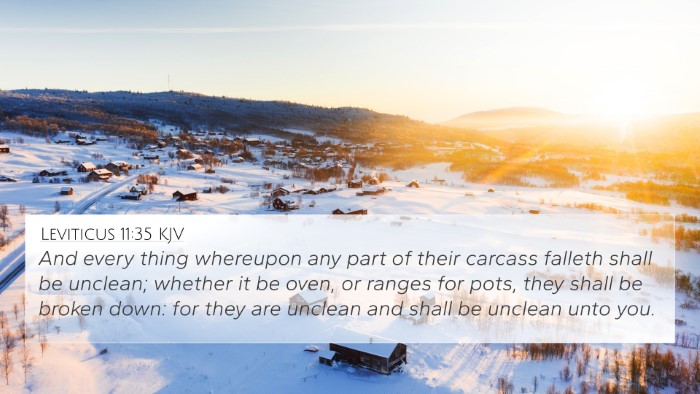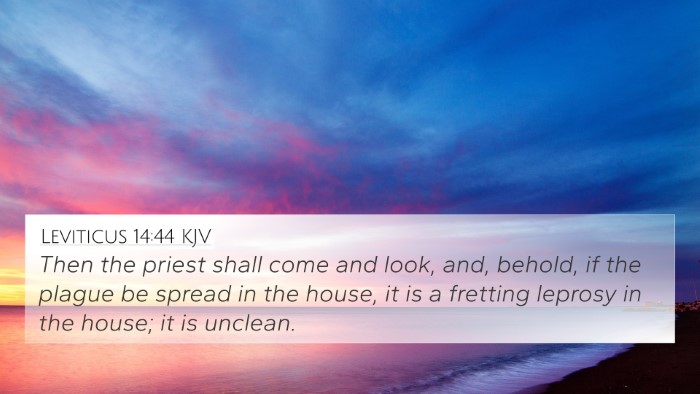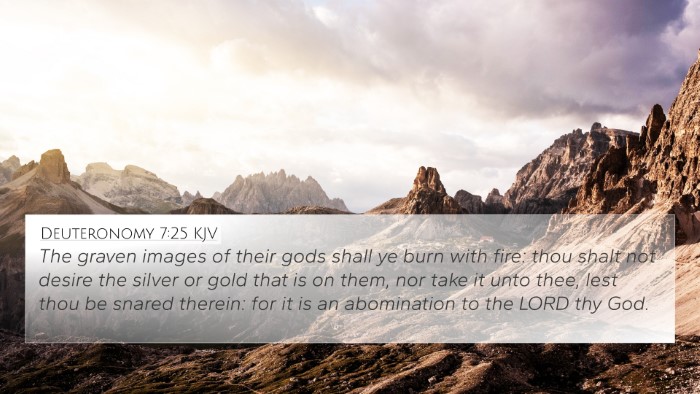Understanding Leviticus 13:52
Verse: "And if the plague be in the garment, either in the warp, or in the woof, or in any thing of skin, it is a plague of leprosy, and shall be shown unto the priest."
Meaning and Interpretation
The directive in Leviticus 13:52 pertains to the identification of leprosy, a serious skin condition, specifically in garments and leather items. This verse highlights the importance of cleanliness and the symbolic nature of skin diseases in the context of the Israelites' covenant with God.
Commentary Insights
-
Matthew Henry: Henry emphasizes the significance of the priest's role in discerning leprosy. He interprets this as a metaphor for spiritual impurities within the community, stressing the necessity of cleansing and the identification of sin. Leprosy in garments symbolizes contamination that extends beyond the physical, representing a broader call to moral purity.
-
Albert Barnes: Barnes notes that the verse indicates that leprosy is not restricted to human beings but can also affect material possessions. This affirms the idea that anything associated with sin or contamination is subject to scrutiny and must be cleansed. He emphasizes the need for a priest to examine these items, presenting the priest as a mediator in maintaining community health and holiness.
-
Adam Clarke: Clarke provides insight into the procedural aspects of the examination of leprous garments. He explains that garments could hold ceremonial uncleanliness, requiring identification and separation. This serves as a form of divine regulation to maintain public health within the Israelite camps, illustrating God's concern for both spiritual and communal purity.
Cross-References for Leviticus 13:52
- Leviticus 13:47-50: These verses lay out the broader context of contamination, addressing various materials and specifying how to handle items showing signs of plague.
- Numbers 19:11-22: Discusses the significance of cleansing and the laws associated with maintaining purity in the Israelite community.
- Luke 17:12-14: In the New Testament, Jesus encounters lepers, connecting to the Old Testament understanding of cleanliness and physical healing.
- Matthew 8:2-4: The interaction between Jesus and the leper reveals the transition from the old law to the new covenant, showcasing Jesus' authority over leprosy.
- Isaiah 1:18: A call to "come now, let us reason together," illustrating God's desire for spiritual renewal and cleansing, reflecting thematic connections to Leviticus.
- Hebrews 9:22: Discusses the necessity of blood for purification, linking the ceremonial laws of the Old Testament to the atoning sacrifice in the New Testament.
- 1 Corinthians 5:6-7: Paul speaks about cleansing the old leaven in relation to sin, drawing a parallel between physical leprosy and spiritual impurity.
Connections and Themes
The thematic connections across these scriptures show the importance of purity—both physical and spiritual—in the community of faith. Leviticus 13:52 illustrates that cleanliness extends beyond individual health, affecting communal well-being and spiritual integrity.
Thematic Bible Verse Connections
- Understanding the relationship between physical and spiritual cleanliness.
- God's laws regarding health as reflections of His holiness.
- The role of church leaders in maintaining purity within the congregation.
Resources for Cross-Referencing
Utilizing tools for Bible cross-referencing can enhance your understanding of scripture. A Bible concordance can help identify related verses, while a cross-reference Bible study guide can facilitate deeper thematic exploration.
Conclusion
Leviticus 13:52 calls for the church today to reflect on its standards of purity. By examining connections between scriptures, believers can draw valuable lessons about moral integrity, the role of leadership in maintaining health, and God's overarching desire for a holy people.








